2009 CHEVROLET TRAVERSE light
[x] Cancel search: lightPage 335 of 422

The grades are molded on the
sidewalls of most passenger car
tires. The Uniform Tire Quality
Grading (UTQG) system does
not apply to deep tread,
winter-type snow tires,
space-saver, or temporary use
spare tires, tires with nominal rim
diameters of 10 to 12 inches
(25 to 30 cm), or to some
limited-production tires.
While the tires available on
General Motors passenger cars
and light trucks may vary with
respect to these grades, they
must also conform to federal
safety requirements and
additional General Motors Tire
Performance Criteria (TPC)
standards.
Treadwear
The treadwear grade is a
comparative rating based
on the wear rate of the tire when
tested under controlled
conditions on a speci�ed
government test course.For example, a tire graded 150
would wear one and a half
(1.5) times as well on the
government course as a tire
graded 100. The relative
performance of tires depends
upon the actual conditions of
their use, however, and may
depart signi�cantly from the norm
due to variations in driving habits,
service practices, and differences
in road characteristics and
climate.
Traction – AA, A, B, C
The traction grades, from highest
to lowest, are AA, A, B, and C.
Those grades represent the
tire’s ability to stop on wet
pavement as measured under
controlled conditions on speci�ed
government test surfaces of
asphalt and concrete. A tire
marked C may have poor traction
performance.Temperature – A, B, C
The temperature grades
are A (the highest), B, and C,
representing the tire’s resistance
to the generation of heat and
its ability to dissipate heat
when tested under controlled
conditions on a speci�ed indoor
laboratory test wheel. Sustained
high temperature can cause
the material of the tire to
degenerate and reduce tire life,
and excessive temperature
can lead to sudden tire failure.
The grade C corresponds to
a level of performance which
all passenger car tires must
meet under the Federal Motor
Vehicle Safety Standard
No. 109. Grades B and A
represent higher levels of
performance on the laboratory
test wheel than the minimum
required by law. It should
be noted that the temperature
grade for this tire is established
for a tire that is properly
in�ated and not overloaded.
Service and Appearance Care 5-53
Page 342 of 422
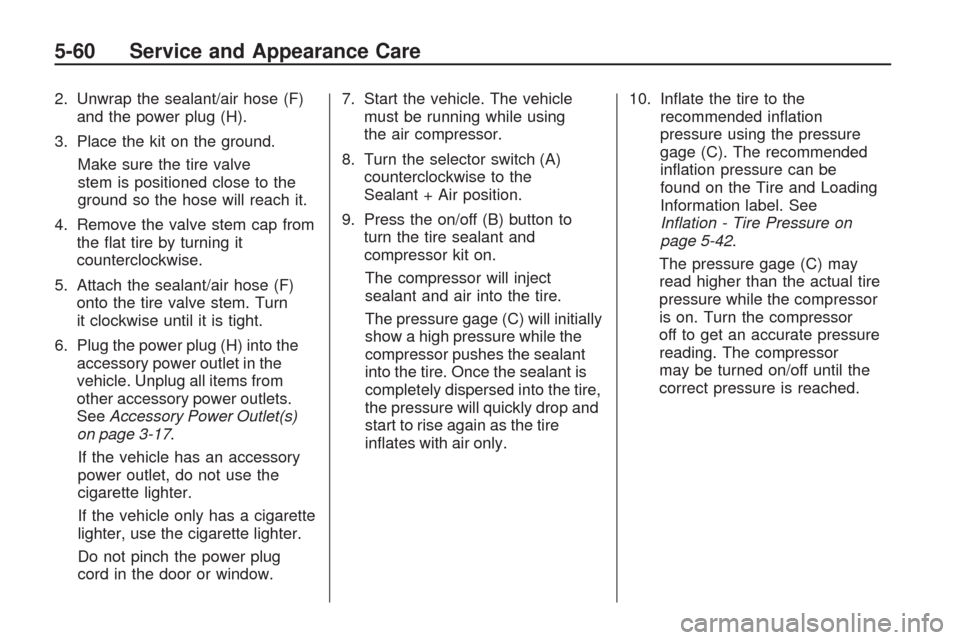
2. Unwrap the sealant/air hose (F)
and the power plug (H).
3. Place the kit on the ground.
Make sure the tire valve
stem is positioned close to the
ground so the hose will reach it.
4. Remove the valve stem cap from
the �at tire by turning it
counterclockwise.
5. Attach the sealant/air hose (F)
onto the tire valve stem. Turn
it clockwise until it is tight.
6. Plug the power plug (H) into the
accessory power outlet in the
vehicle. Unplug all items from
other accessory power outlets.
SeeAccessory Power Outlet(s)
on page 3-17.
If the vehicle has an accessory
power outlet, do not use the
cigarette lighter.
If the vehicle only has a cigarette
lighter, use the cigarette lighter.
Do not pinch the power plug
cord in the door or window.7. Start the vehicle. The vehicle
must be running while using
the air compressor.
8. Turn the selector switch (A)
counterclockwise to the
Sealant + Air position.
9. Press the on/off (B) button to
turn the tire sealant and
compressor kit on.
The compressor will inject
sealant and air into the tire.
The pressure gage (C) will initially
show a high pressure while the
compressor pushes the sealant
into the tire. Once the sealant is
completely dispersed into the tire,
the pressure will quickly drop and
start to rise again as the tire
in�ates with air only.10. In�ate the tire to the
recommended in�ation
pressure using the pressure
gage (C). The recommended
in�ation pressure can be
found on the Tire and Loading
Information label. See
Inflation - Tire Pressure on
page 5-42.
The pressure gage (C) may
read higher than the actual tire
pressure while the compressor
is on. Turn the compressor
off to get an accurate pressure
reading. The compressor
may be turned on/off until the
correct pressure is reached.
5-60 Service and Appearance Care
Page 345 of 422
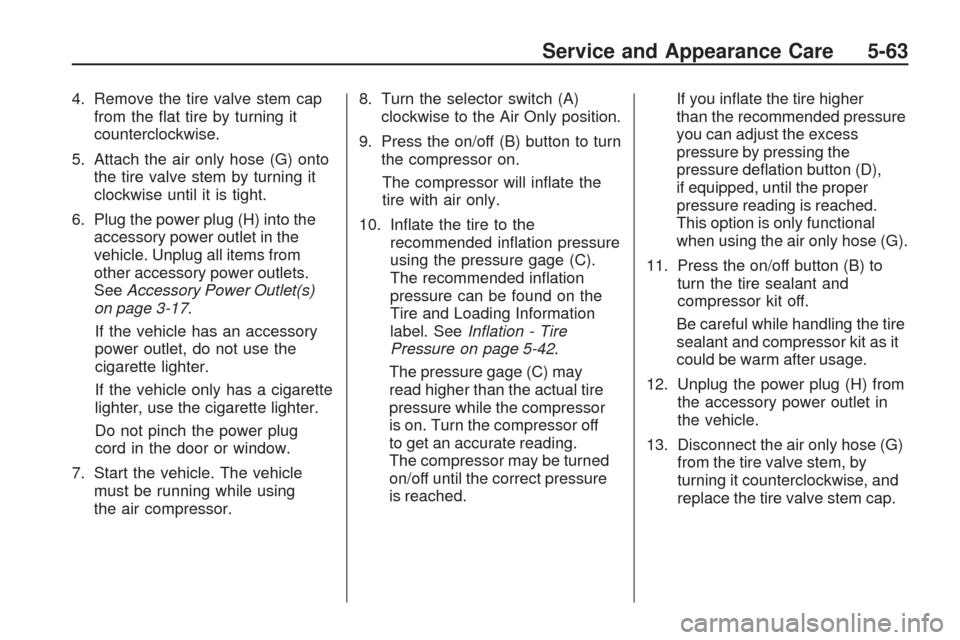
4. Remove the tire valve stem cap
from the �at tire by turning it
counterclockwise.
5. Attach the air only hose (G) onto
the tire valve stem by turning it
clockwise until it is tight.
6. Plug the power plug (H) into the
accessory power outlet in the
vehicle. Unplug all items from
other accessory power outlets.
SeeAccessory Power Outlet(s)
on page 3-17.
If the vehicle has an accessory
power outlet, do not use the
cigarette lighter.
If the vehicle only has a cigarette
lighter, use the cigarette lighter.
Do not pinch the power plug
cord in the door or window.
7. Start the vehicle. The vehicle
must be running while using
the air compressor.8. Turn the selector switch (A)
clockwise to the Air Only position.
9. Press the on/off (B) button to turn
the compressor on.
The compressor will in�ate the
tire with air only.
10. In�ate the tire to the
recommended in�ation pressure
using the pressure gage (C).
The recommended in�ation
pressure can be found on the
Tire and Loading Information
label. SeeInflation - Tire
Pressure on page 5-42.
The pressure gage (C) may
read higher than the actual tire
pressure while the compressor
is on. Turn the compressor off
to get an accurate reading.
The compressor may be turned
on/off until the correct pressure
is reached.If you in�ate the tire higher
than the recommended pressure
you can adjust the excess
pressure by pressing the
pressure de�ation button (D),
if equipped, until the proper
pressure reading is reached.
This option is only functional
when using the air only hose (G).
11. Press the on/off button (B) to
turn the tire sealant and
compressor kit off.
Be careful while handling the tire
sealant and compressor kit as it
could be warm after usage.
12. Unplug the power plug (H) from
the accessory power outlet in
the vehicle.
13. Disconnect the air only hose (G)
from the tire valve stem, by
turning it counterclockwise, and
replace the tire valve stem cap.
Service and Appearance Care 5-63
Page 360 of 422
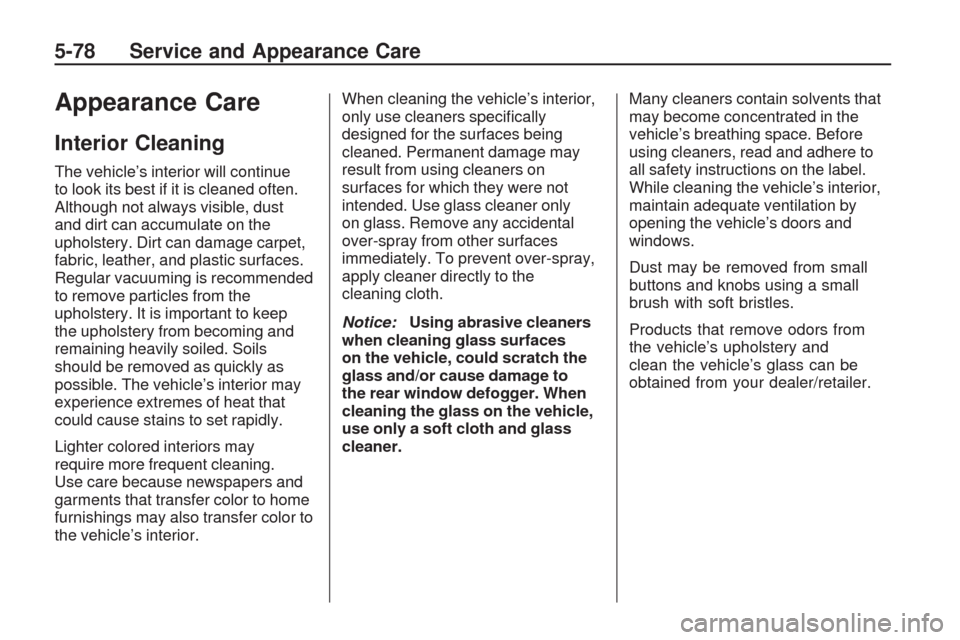
Appearance Care
Interior Cleaning
The vehicle’s interior will continue
to look its best if it is cleaned often.
Although not always visible, dust
and dirt can accumulate on the
upholstery. Dirt can damage carpet,
fabric, leather, and plastic surfaces.
Regular vacuuming is recommended
to remove particles from the
upholstery. It is important to keep
the upholstery from becoming and
remaining heavily soiled. Soils
should be removed as quickly as
possible. The vehicle’s interior may
experience extremes of heat that
could cause stains to set rapidly.
Lighter colored interiors may
require more frequent cleaning.
Use care because newspapers and
garments that transfer color to home
furnishings may also transfer color to
the vehicle’s interior.When cleaning the vehicle’s interior,
only use cleaners speci�cally
designed for the surfaces being
cleaned. Permanent damage may
result from using cleaners on
surfaces for which they were not
intended. Use glass cleaner only
on glass. Remove any accidental
over-spray from other surfaces
immediately. To prevent over-spray,
apply cleaner directly to the
cleaning cloth.
Notice:Using abrasive cleaners
when cleaning glass surfaces
on the vehicle, could scratch the
glass and/or cause damage to
the rear window defogger. When
cleaning the glass on the vehicle,
use only a soft cloth and glass
cleaner.Many cleaners contain solvents that
may become concentrated in the
vehicle’s breathing space. Before
using cleaners, read and adhere to
all safety instructions on the label.
While cleaning the vehicle’s interior,
maintain adequate ventilation by
opening the vehicle’s doors and
windows.
Dust may be removed from small
buttons and knobs using a small
brush with soft bristles.
Products that remove odors from
the vehicle’s upholstery and
clean the vehicle’s glass can be
obtained from your dealer/retailer.
5-78 Service and Appearance Care
Page 363 of 422
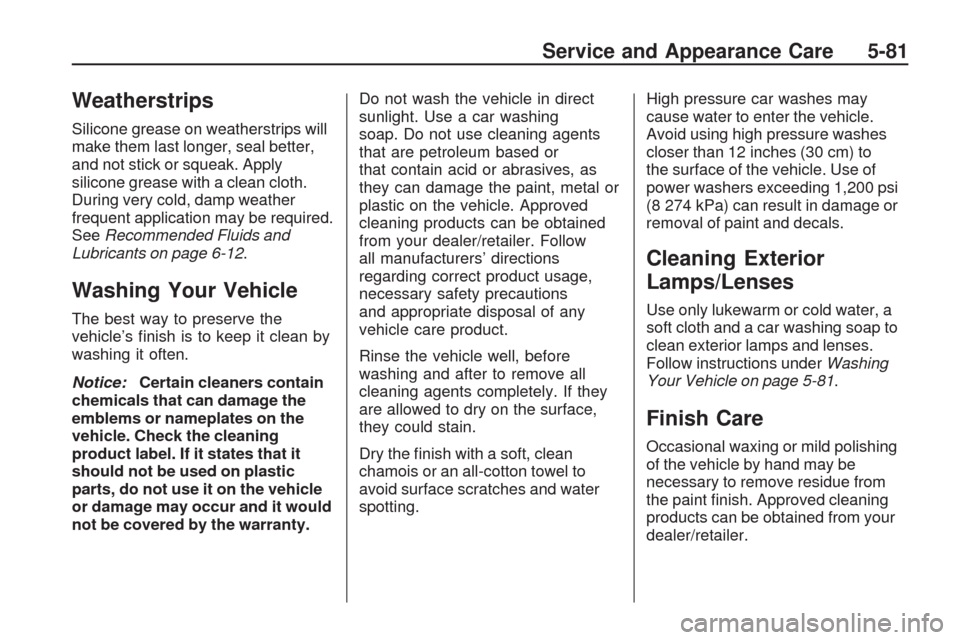
Weatherstrips
Silicone grease on weatherstrips will
make them last longer, seal better,
and not stick or squeak. Apply
silicone grease with a clean cloth.
During very cold, damp weather
frequent application may be required.
SeeRecommended Fluids and
Lubricants on page 6-12.
Washing Your Vehicle
The best way to preserve the
vehicle’s �nish is to keep it clean by
washing it often.
Notice:Certain cleaners contain
chemicals that can damage the
emblems or nameplates on the
vehicle. Check the cleaning
product label. If it states that it
should not be used on plastic
parts, do not use it on the vehicle
or damage may occur and it would
not be covered by the warranty.Do not wash the vehicle in direct
sunlight. Use a car washing
soap. Do not use cleaning agents
that are petroleum based or
that contain acid or abrasives, as
they can damage the paint, metal or
plastic on the vehicle. Approved
cleaning products can be obtained
from your dealer/retailer. Follow
all manufacturers’ directions
regarding correct product usage,
necessary safety precautions
and appropriate disposal of any
vehicle care product.
Rinse the vehicle well, before
washing and after to remove all
cleaning agents completely. If they
are allowed to dry on the surface,
they could stain.
Dry the �nish with a soft, clean
chamois or an all-cotton towel to
avoid surface scratches and water
spotting.High pressure car washes may
cause water to enter the vehicle.
Avoid using high pressure washes
closer than 12 inches (30 cm) to
the surface of the vehicle. Use of
power washers exceeding 1,200 psi
(8 274 kPa) can result in damage or
removal of paint and decals.
Cleaning Exterior
Lamps/Lenses
Use only lukewarm or cold water, a
soft cloth and a car washing soap to
clean exterior lamps and lenses.
Follow instructions underWashing
Your Vehicle on page 5-81.
Finish Care
Occasional waxing or mild polishing
of the vehicle by hand may be
necessary to remove residue from
the paint �nish. Approved cleaning
products can be obtained from your
dealer/retailer.
Service and Appearance Care 5-81
Page 371 of 422
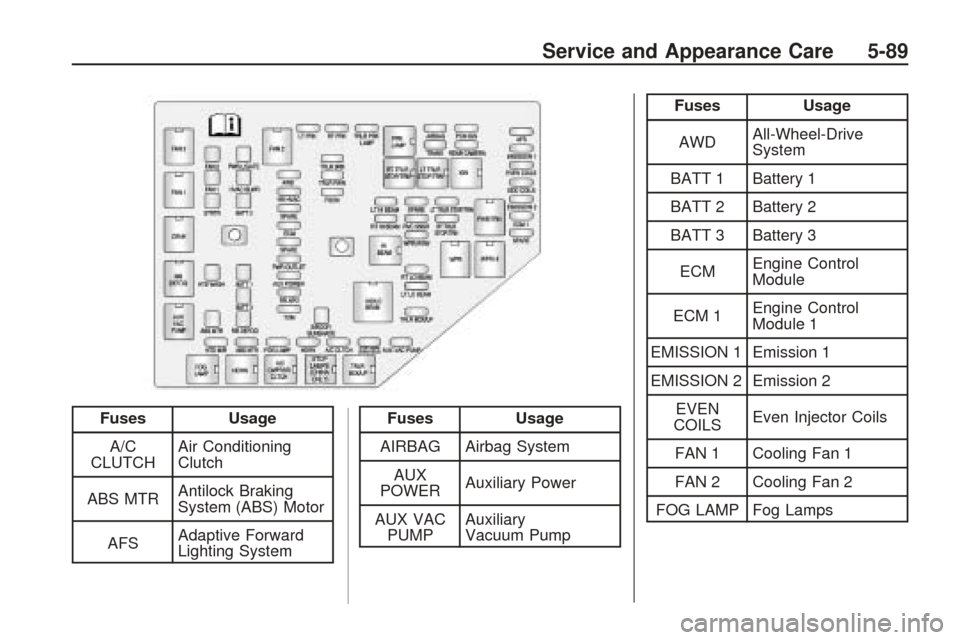
FusesUsage
A/C
CLUTCH Air Conditioning
Clutch
ABS MTR Antilock Braking
System (ABS) Motor
AFS Adaptive Forward
Lighting SystemFuses
Usage
AIRBAG Airbag System AUX
POWER Auxiliary Power
AUX VAC PUMP Auxiliary
Vacuum Pump
Fuses
Usage
AWD All-Wheel-Drive
System
BATT 1 Battery 1
BATT 2 Battery 2
BATT 3 Battery 3
ECM Engine Control
Module
ECM 1 Engine Control
Module 1
EMISSION 1 Emission 1
EMISSION 2 Emission 2 EVEN
COILS Even Injector Coils
FAN 1 Cooling Fan 1
FAN 2 Cooling Fan 2
FOG LAMP Fog Lamps
Service and Appearance Care 5-89
Page 382 of 422

(e)Make sure the safety belt
reminder light and safety belt
assemblies are working properly.
Look for any other loose or damaged
safety belt system parts. If you see
anything that might keep a safety
belt system from doing its job, have
it repaired. Have any torn or frayed
safety belts replaced. Also see
Checking the Restraint Systems
on page 1-59.
(f)Lubricate all key lock cylinders,
hood latch assemblies, secondary
latches, pivots, spring anchor and
release pawl, hood and door hinges,
rear folding seats, and liftgate
hinges. More frequent lubrication
may be required when exposed to
a corrosive environment. Applying
silicone grease on weatherstrips with
a clean cloth will make them last
longer, seal better, and not stick
or squeak.
(g)A fluid loss in any vehicle system
could indicate a problem. Have the
system inspected and repaired and
the fluid level checked. Add fluid if
needed.(h)Change automatic transmission
fluid if the vehicle is mainly driven
under one or more of these
conditions:
�In heavy city traffic where the
outside temperature regularly
reaches 90°F (32°C) or higher.
�In hilly or mountainous terrain.
�When doing frequent trailer
towing.
�Uses such as found in taxi, police,
or delivery service.
(i)Drain, flush, and refill cooling
system. This service can be
complex; you should have your
dealer/retailer perform this service.
See Engine Coolant on page 5-17 for
what to use. Inspect hoses. Clean
radiator, condenser, pressure cap,
and filler neck. Pressure test the
cooling system and pressure cap.(j)Check system for interference or
binding and for damaged or missing
parts. Replace parts as needed.
Replace any components that have
high effort or excessive wear. Do not
lubricate accelerator or cruise control
cables.
(k)Visually inspect belt for fraying,
excessive cracks, or obvious
damage. Replace belt if necessary.
(l)If driving regularly under dusty
conditions, inspect the filter at each
engine oil change.
(m)Change transfer case fluid if the
vehicle is mainly driven under one
or more of these conditions:
�In heavy city traffic where the
outside temperature regularly
reaches 90°F (32°C) or higher.
�In hilly or mountainous terrain.
�When doing frequent trailer
towing.
�Uses such as found in taxi, police,
or delivery service.
6-8 Maintenance Schedule
Page 411 of 422

A
Accessories and
Modi�cations...................... 5-3
Accessory Power.................2-22
Accessory Power Outlets......3-17
Adding Equipment to Your
Airbag-Equipped Vehicle....1-58
Additional Required Services,
Scheduled Maintenance....... 6-6
Additives, Fuel...................... 5-5
Add-On Electrical
Equipment.......................5-86
Air Cleaner/Filter, Engine.......5-15
Air Conditioning...................3-19
Airbag
Readiness Light................3-33
Airbag System.....................1-46
Adding Equipment to
Your Airbag-Equipped
Vehicle........................1-58
How Does an Airbag
Restrain?.....................1-51
Passenger Sensing
System........................1-53
Servicing Your
Airbag-Equipped
Vehicle........................1-57Airbag System (cont.)
What Makes an Airbag
In�ate?........................1-51
What Will You See After
an Airbag In�ates?........1-51
When Should an Airbag
In�ate?........................1-49
Where Are the Airbags?.....1-48
Airbags
Passenger Status
Indicator.......................3-33
All-Wheel-Drive (AWD)
System............................. 4-7
Antilock Brake System (ABS) . . . 4-4
Warning Light...................3-37
Appearance Care
Aluminum or
Chrome-Plated Wheels . . . 5-83
Care of Safety Belts..........5-80
Chemical Paint Spotting.....5-84
Cleaning Exterior
Lamps/Lenses...............5-81
Fabric/Carpet...................5-79
Finish Care......................5-81
Finish Damage.................5-84
Instrument Panel, Vinyl,
and Other Plastic
Surfaces......................5-80Appearance Care (cont.)
Interior Cleaning...............5-78
Leather...........................5-80
Sheet Metal Damage........5-84
Tires...............................5-83
Underbody Maintenance....5-84
Washing Your Vehicle........5-81
Weatherstrips...................5-81
Windshield, Backglass,
and Wiper Blades..........5-82
Assistance Program,
Roadside.......................... 7-6
Audio System......................3-73
Audio Steering Wheel
Controls.....................3-125
Navigation/Radio
System, see
Navigation Manual.......3-103
Setting the Clock..............3-74
Audio System(s)..................3-75
Audio Systems
Radio Reception.............3-126
Rear Seat (RSA).............3-123
Theft-Deterrent Feature....3-125
Automatic Transmission
Fluid...............................5-16
Operation........................2-24
INDEX i-1